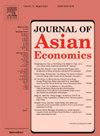China's labor market demand in the shadow of COVID-19: Evidence from an online job board
IF 2.9
3区 经济学
Q1 ECONOMICS
引用次数: 0
Abstract
Using data of the largest online job board in China, Zhaopin.com, we examine the impacts of the lockdown policy on the Chinese labor market demand during the coronavirus disease (COVID-19) pandemic. The analyses reveal that the lockdown policy, which was implemented in Wuhan on January 23, 2020, reduced the labor market demand drastically. Specifically, the “Number of Companies” that posted weekly job vacancies, “Number of Positions,” and “Number of Employees” to be recruited reduced rapidly by 15.7 %, 18 %, and 23 %, respectively. Furthermore, this impact of the lockdown policy began to reduce, thus allowing the labor demand to rebound four weeks after the outbreak. The heterogeneity analyses reveal that the industries with high physical proximity and those manufacturing non-essential products/services, as well as small-size firms, were greatly impacted by the policy. The adverse impacts in the cities that implemented specific control measures were stronger than in those that did not. This study quantifies the dynamic impacts of China’s stringent control measures on the country’s labor demand during the pandemic. These findings indicate that the effective management of public health crises in conjunction with economic policies is critical to revitalizing labor markets.
COVID-19阴影下的中国劳动力市场需求:来自在线招聘板的证据
我们利用中国最大的在线招聘网站智联招聘的数据,研究了冠状病毒病(COVID-19)大流行期间封锁政策对中国劳动力市场需求的影响。分析表明,2020年1月23日武汉实施的封锁政策大幅减少了劳动力市场需求。具体而言,每周公布职位空缺的“公司数量”、“职位数量”和“招聘人数”分别减少了15.7% %、18% %和23% %。此外,封锁政策的影响开始减弱,从而使劳动力需求在疫情发生四周后出现反弹。异质性分析表明,高物理接近度行业、非必需产品/服务制造业以及小型企业受政策影响较大。实施具体控制措施的城市的负面影响要大于未实施具体控制措施的城市。本研究量化了疫情期间中国严格控制措施对该国劳动力需求的动态影响。这些调查结果表明,结合经济政策有效管理公共卫生危机对于振兴劳动力市场至关重要。
本文章由计算机程序翻译,如有差异,请以英文原文为准。
求助全文
约1分钟内获得全文
求助全文
来源期刊

Journal of Asian Economics
ECONOMICS-
CiteScore
4.70
自引率
9.40%
发文量
90
期刊介绍:
The Journal of Asian Economics provides a forum for publication of increasingly growing research in Asian economic studies and a unique forum for continental Asian economic studies with focus on (i) special studies in adaptive innovation paradigms in Asian economic regimes, (ii) studies relative to unique dimensions of Asian economic development paradigm, as they are investigated by researchers, (iii) comparative studies of development paradigms in other developing continents, Latin America and Africa, (iv) the emerging new pattern of comparative advantages between Asian countries and the United States and North America.
 求助内容:
求助内容: 应助结果提醒方式:
应助结果提醒方式:


